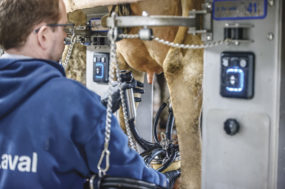To read this article in French, click here.
As they say, "They don’t make land anymore." The price and access to workable ground are some of the prohibiting factors keeping new farmers from entering the industry. As the planet’s population increases, it is a problem that is only getting worse, despite organizational and governmental efforts in various countries to keep land for agriculture. One solution?
Try the moon instead.
Last year, scientists at the University of Florida took soil from the moon – collected from past Apollo missions – and grew plants in it. Just like that, space settlement became a little more likely.
The lunar soil, or regolith, was brought back from Apollo 11, 12 and 17 – with some of it stored in a sealed vacuum for more than 50 years. Scientists planted thale cress (Arabidopsis thaliana) in 1 gram of regolith per plant. Thale cress is not only known to be a hardy and adaptable plant but also has been studied extensively by scientists, with its genome already mapped. A nutrient solution was given to the plants daily. Although the plants did not grow as well as they would in Earth’s soil and showed signs of being under stress, they did in fact survive, which means that the soil on the moon contains the necessary nutrients to support life. While the project is largely academic at this point, it can very well be good news for hungry astronauts in the future.
With NASA's Artemis program, the U.S. is looking to send people back to the moon in the next few years. As long-term lunar exploration continues – including the possibility of building stations on the moon – crews will need to be fed. There is only so much room in spaceships. The ability to grow food on the moon will be significant to the viability of an enduring presence there.
While the persistence of a plucky weedlike plant in moon dirt is good news for lunar agriculture, there’s still a long way to go. Even though there are sufficient minerals in regolith for plants (except nitrogen), one of the challenges is that it compacts in the presence of water. Being so dense, it makes root growth difficult to sustain. However, the European Space Agency (ESA), in partnership with the Norwegian company SolSys Mining, might have found a way around that in the form of hydroponic farming.
With the goal of using as much of the moon’s natural resources as possible, the project – with the very catchy name of "Enabling Lunar In-Situ Agriculture by Producing Fertilizer from Beneficiated Regolith" – seeks to create a greenhouse system based on the minerals already in the regolith. While the project is still in development, the idea is to subject lunar soil to a mechanical sorting process, after which it gets chemically leached to isolate the important nutrients. The valuable elements are then put in a water solution and implemented into a hydroponic gardening system. If all goes well, life could be sustained on a surface that was once considered uninhabitable.
Although recent developments are a major step toward realistic settlement in space, the idea is not new. The Mars One organization tried to create a community on the red planet, pioneering the final frontier. Instead, it epically failed and has since been deemed a scam. The enterprise had promised to send people on a one-way ticket to Mars to live out the rest of their days, adding new members to the settlement in subsequent trips. The Dutch organization behind it, however, was not an aerospace company and planned to fund the venture by selling the TV rights. Scientists called it a suicide mission, with Massachusetts Institute of Technology (MIT) researchers predicting that, based on the Mars One model, the first person would die 14 days after arrival, and the rest quickly after. The CEO of the company suggested that the first trip to Mars would cost $6 billion, while NASA estimated it to require $100 billion. In 2019, Mars One declared bankruptcy, with investors losing their money.
The first people in a new place are – by necessity – farmers. Without the ability to feed themselves, they wouldn’t last long. Those first farmers on the moon, however, are going to have it tough. With reduced gravity, extremes in temperature and radiation and a complete lack of atmosphere, it will be nothing like the spring days in the field they’re used to. In fact, there would pretty much be only one view: to look in the sky and see all of the rest of us back on Earth. Still, most people in the U.S. are descendants of settlers who moved there from other countries and broke ground. Perhaps there’s something analogous to relocating within the solar system.
Moon farming might not be the next big thing in agriculture, but it also might not be that far off.




